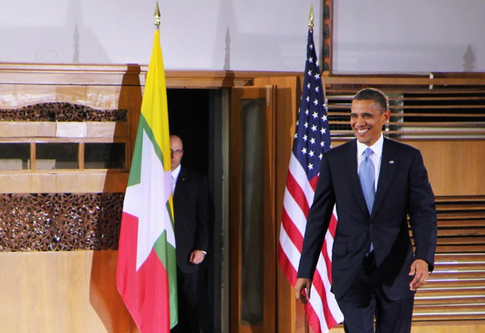(Yangon, Myanmar) – The President arrived in Yangon to streets lined with almost overwhelmingly adoring Burmese bystanders, waving US flags and clad in “Welcome Obama” T-shirts. Some Burmese have taken to referring to Obama as U-Bama, substituting the first letter of his name with a typical Burmese male honorific.
No US president had ever visited Burma until Monday: it was a historical event many felt they couldn’t afford to miss.
Obama’s speech took place at Yangon University, a campus with a storied history in Myanmar’s long fight for democracy. It was also a decidedly symbolic choice of venue, as the President could have easily paid a visit to Myanmar’s ruling class at the newly-minted, empty capital at Naw Piy Daw.
Mostly shuttered in the 1990s after the government decided it was entirely too fertile ground for student revolt, the mouldering campus’s soaring Convocation Hall was overhauled for the President’s visit. It’s rumored that the campus will open again in the near future for classes, a major victory for Burma’s long neglected intelligentsia.
Obama’s speech felt almost like a lecture, directed especially at Burma’s leadership. He enumerated Franklin Delano Roosevelt’s Four Freedoms, and emphasized that the USA was willing to serve as a role-model for Myanmar’s nascent democracy. His tone was professorial, almost chiding.
Many in the audience were doubtless watching especially closely for Obama’s comments on the Rohingya, the victims of brutal Buddhist-on-Muslim violence in Myanmar’s eastern regions.
Obama stayed diplomatic, but addressed the issue head on. “The Rohingya hold within themselves the same dignity that you do, and I do,” said Obama.
“I have confidence that you can draw on diversity as a strength and not a weakness,” he added, alluding to the USA’s diversity as a role-model for Myanmar.
Iconic National League for Democracy leader Aung Sang Suu Kyi has drawn considerable flack in recent months for her curious unwillingness to take a stand on the Rohingya issue.
She was present (and prominently so) in the audience today, and Obama met with her at her lake-side house earlier in the day, continuing his administration’s support of The Lady.
Obama’s comments on Myanmar’s pressing need for national reconciliation drew much boisterous applause Monday, perhaps bolstered by the minority-group representatives attending the speech, including representatives from the contested Kachin and Chin states.
“We will extend a hand if you are willing to unclench your fist,” said Obama to the assembled crowd, drawing on the fist theme he’d earlier established with Iran.
What comes next, after this symbolic re-opening—both of the university, and with US relations with Myanmar?
The numerous cowboy businesspeople who have turned up in Yangon in recent months may tell part of the story, as do the ever-increasing numbers of tourists streaming through the smallish central airport.
America has lifted its sanctions, and investors are looking with extreme interest on this large and resource-rich—and strategically important—nation.
As Obama heads to Cambodia on the second leg of his three-country ASEAN journey, Myanmar may want to reflect on their nearly-neighbors economic and enviromentalfate since opening up to the world economy in the 1990s.
Obama himself warned that Myanmar must extend new-found economic prosperity to everyone, not just the top tier of society. It remains to be seen if this advice will be heeded.

